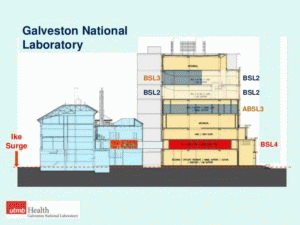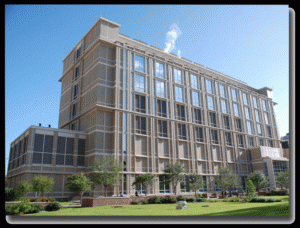From Consortium News
Concern is rising for the safety of a biological lab containing deadly diseases on Galveston island, which has been hit by the massive storm devastating southeast Texas.
The Galveston National Laboratory on the campus of the University of Texas Medical Branch contains samples of hundreds of viruses, insects and microbes, which could spread extreme danger if they were to escape. There are several Bio-safety Level 4 labs at Galveston. BSL-4 is the highest level precaution taken for work with agents that can be transmitted through the air and cause fatal diseases in humans for which there are no known cures.
According to its website, the high security national bio-containment lab's mission is to develop "therapies, vaccines, and diagnostic tests for naturally occurring emerging diseases such as SARS, West Nile encephalitis and avian influenza -- as well as for microbes that might be employed by terrorists."
There has been almost no news from Galveston as journalists have reported being blocked from reaching the island because of severe flooding. There has been no reporting at all on the condition of the lab. A call to the laboratory on Tuesday immediately went to voicemail.
The lab's website says "plans are in place to shut down and secure all laboratory operations if a hurricane landfall is predicted near Galveston." It says that "this shut-down and decontamination can be done quickly, with all work in the facility ceasing, the lab locked down, and all infectious agents and biological and chemical material placed into safe and secure storage."
A 2008 article in The New York Times about the laboratory said, "Each time a hurricane approaches the island, scientists will have to stop their experiments and exterminate many of the viruses and bacteria they are studying."
Uncertain Warning
It is not clear how much warning the Galveston lab had. Last Wednesday the National Oceanic and Atmospheric Administration tweeted that "remnants of Trop. Storm Harvey have regenerated into a Tropical Depression." On Thursday NOAA tweeted about "rapidly strengthening ... Tropical Storm #Harvey as it moves toward #Texas." Later on Thursday it upgraded the storm to a hurricane. On Friday it was declared a Category 2 hurricane on the same day it surged to Category 4 and made landfall.

Schematic design of Galveston National Laboratory.
(Image by (Photo credit: Galveston National Library)) Details DMCA
The lab says that its $174 million facilities have been constructed to withstand a Category 5 storm. The eight-story buildings containing the labs have pilings into the earth 121 feet deep. All the lab facilities are at least 30 feet above ground, high enough to withstand even the most severe flooding, the website said. The building is supposed to survive 140 mph winds.
The National Weather Service has called this storm "unprecedented" and "beyond anything experienced" before. The storm has so far dropped 48 inches of rain on Houston, a record for a single storm in the continental U.S. About half a million people will need help from the federal government to recover.
With electric power out to at least 100,000 customers in southeast Texas, there is fear that electricity going out at the lab would release the pressure needed to contain the deadly bugs in their secure storage containers.
"State-of-the-art systems built into the design of the GNL help protect workers and prevent any release of infectious agents," the lab says on its website. "Double and triple redundancies in equipment and systems help ensure that if an unexpected failure does occur, a backup is in place to maintain safety."
Generators Need Fuel
(Note: You can view every article as one long page if you sign up as an Advocate Member, or higher).






